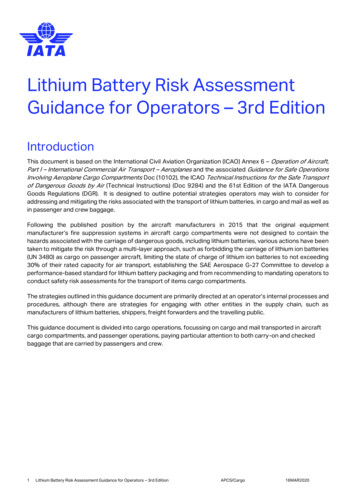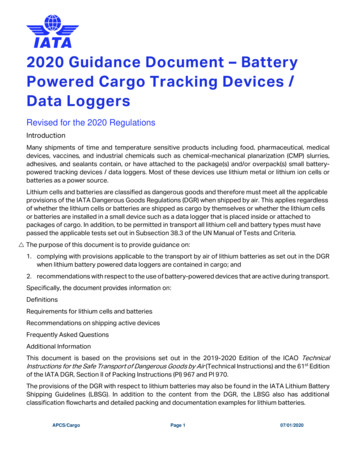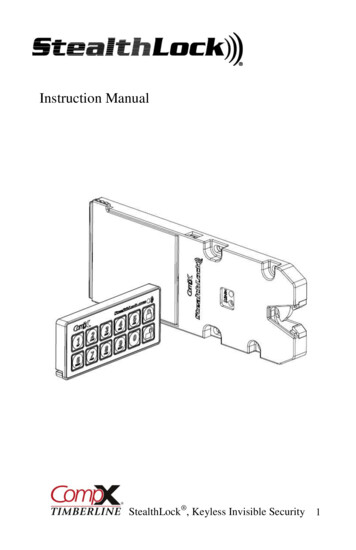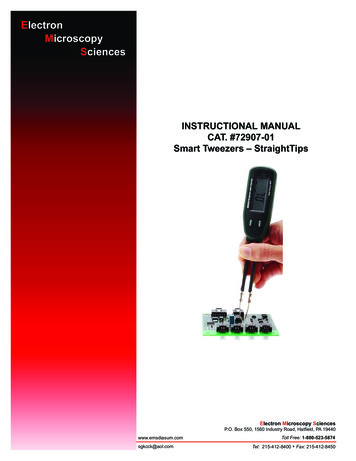
Transcription
Lithium Battery Risk AssessmentGuidance for Operators – 3rd EditionIntroductionThis document is based on the International Civil Aviation Organization (ICAO) Annex 6 – Operation of Aircraft,Part I – International Commercial Air Transport – Aeroplanes and the associated Guidance for Safe OperationsInvolving Aeroplane Cargo Compartments Doc (10102), the ICAO Technical Instructions for the Safe Transportof Dangerous Goods by Air (Technical Instructions) (Doc 9284) and the 61st Edition of the IATA DangerousGoods Regulations (DGR). It is designed to outline potential strategies operators may wish to consider foraddressing and mitigating the risks associated with the transport of lithium batteries, in cargo and mail as well asin passenger and crew baggage.Following the published position by the aircraft manufacturers in 2015 that the original equipmentmanufacturer’s fire suppression systems in aircraft cargo compartments were not designed to contain thehazards associated with the carriage of dangerous goods, including lithium batteries, various actions have beentaken to mitigate the risk through a multi-layer approach, such as forbidding the carriage of lithium ion batteries(UN 3480) as cargo on passenger aircraft, limiting the state of charge of lithium ion batteries to not exceeding30% of their rated capacity for air transport, establishing the SAE Aerospace G-27 Committee to develop aperformance-based standard for lithium battery packaging and from recommending to mandating operators toconduct safety risk assessments for the transport of items cargo compartments.The strategies outlined in this guidance document are primarily directed at an operator’s internal processes andprocedures, although there are strategies for engaging with other entities in the supply chain, such asmanufacturers of lithium batteries, shippers, freight forwarders and the travelling public.This guidance document is divided into cargo operations, focussing on cargo and mail transported in aircraftcargo compartments, and passenger operations, paying particular attention to both carry-on and checkedbaggage that are carried by passengers and crew.1Lithium Battery Risk Assessment Guidance for Operators – 3rd EditionAPCS/Cargo16MAR2020
BackgroundLithium batteries power many portable electronic devices (PEDs) as well as heavy duty machinery and vehicles;they have become the battery of choice due to their high energy density, which allows them to operate for a longduration, and the availability of various types with different chemistries makes them suitable for a wide range ofelectronic products. These batteries and the products that are operated by them are also very often transportedby air because of the tight timeframe to assemble the products and consequentially to launch the products in atimely manner, the short product shelf-life and sometimes need to be delivered at short notice in the case of lifesaving medical devices.There are well-established and stringent international requirements applicable to the manufacture, testing andtransport of lithium batteries, and the legitimate lithium battery industry has an outstanding safety record sincethese batteries started to be transported by air in the mid-1970s; however, they can possibly go into a thermalrunaway if the design type has not been subjected to mandatory safety tests or they are not handled properlyand subsequently lead to deformation. In addition, with the reported occurrences of undeclared dangerousgoods around the world, consideration must always be given to the potential of undeclared dangerous goods,which may also present a significant risk.Overview of Lithium BatteriesA battery is defined as two or more cells which are electrically connected together and fitted with devicesnecessary for use, for example, a case, terminals, marking and protective devices. The term “lithium battery”refers to a family of different chemistries, comprising many types of cathodes and electrolytes. Units that arecommonly referred to as “battery packs”, “modules”, “battery assemblies”, “power banks”, or “power generators”having the primary function of providing a source of power to another piece of equipment are for the purposesof this guidance document and the IATA Dangerous Goods Regulations, to be classified as batteries.Lithium batteries are separated into two main categories, lithium metal batteries and lithium-ion batteries:Lithium metal batteries are generally primary (non-rechargeable) batteries that have lithium metal or lithiumcompounds as an anode. Also included in this category are lithium alloy batteries. Lithium metal batteries aregenerally used to power devices such as watches, calculators, cameras, temperature data loggers, car key fobsand defibrillators.NOTE:Lithium metal batteries packed by themselves (not contained in or packed with equipment) (Packing Instruction968) are forbidden for transport as cargo on passenger aircraft, unless shipped under the conditions of anexemption issued by all States concerned, or as permitted under an approval in accordance with SpecialProvision A201.Figure 1 – Example of lithium metal cells and batteries2Lithium Battery Risk Assessment Guidance for Operators – 3rd Edition
Lithium-ion batteries (sometimes abbreviated to Li-ion batteries) are secondary (rechargeable) batterieswhere the lithium is only present in an ionic form in the electrolyte. Also included within the category of lithiumion batteries are lithium polymer batteries. Lithium-ion batteries are generally used to power devices such asmobile telephones, laptop computers, tablets, power tools and e-bikes.Figure 2 – Example of lithium ion cells and batteriesNote:Lithium ion batteries packed by themselves (Packing Instruction 965) (not contained in or packed withequipment):(a) must be shipped at a state of charge (SoC) not exceeding 30% of their rated capacity. Cells and/orbatteries at a SoC of greater than 30% may only be shipped with the approval of the State of Origin and theState of the Operator under the written conditions established by those authorities, see Special ProvisionA331; and(b) are forbidden for transport as cargo on passenger aircraft, unless shipped under the conditions of anexemption issued by all States concerned, or as permitted under an approval in accordance with SpecialProvision A201.More information about the safe transport of lithium batteries by air can be found in the IATA Lithium BatteryGuidance Document (www.iata.org/lithiumbatteries).3Lithium Battery Risk Assessment Guidance for Operators – 3rd Edition
Cargo OperationsChallengesBecause of the huge, worldwide demand for lithium batteries, billions of them are shipped annually as air cargo.Volumes are expected to increase substantially over the coming years, with batteries becoming smaller, morepowerful and even more longer lasting. The IATA Dangerous Goods Board previously estimated that, on someroutes, lithium batteries were present in some 25% of cargo shipments. This estimate only takes into accountthose lithium batteries that are known to be transported (i.e. those that have been declared to the operator). Itdoes not include undeclared shipments, the exact amount of which is unknown.Counterfeit & Substandard Lithium BatteriesAccording to the international air transport regulations, each cell or battery type must be proven to have metthe requirements of each test of the UN Manual of Tests and Criteria, Part III, subsection 38.3 (i.e. UN 38.3 test).However, many lithium batteries that do not meet the UN 38.3 test requirements are available for sale on theInternet and in some parts of the world. These batteries are sometimes manufactured to look alike to thegenuine branded products and are very often sold at a price that is far cheaper than the genuine products. Asthese batteries have not been tested to the UN 38.3 test standards, they are less safe to transport, with higherpotential risk and may fail or catch fire when subjected to the shocks and loadings encountered under thenormal conditions of transport.Figure 3 – Information on counterfeit batteries released by Sony es/00200938)4Lithium Battery Risk Assessment Guidance for Operators – 3rd Edition
Undeclared Lithium BatteriesLithium batteries have become such a common, everyday commodity that they have been taken for granted byconsumers, with little thought given to the precautions that need to be taken to ensure lithium batteries do notpose a risk in air transport. This is an issue for passenger baggage as well as air cargo. Experience has shownthat there are shippers who, either deliberately or through ignorance, do not follow the requirements set out inthe DGR. Consequently, incidents involving lithium batteries catching fire on board aircraft have occurred. It isnot always possible to determine the cause of such incidents, but where a cause has been determined, theywould appear to be almost invariably due to non-compliance with the requirements.Figure 4 – Fire damage to a package of incorrectly packed lithium metal button cells, which occurred after unloadingThere was a great deal of publicity surrounding the loss of three cargo aircraft due to on board cargo fires: 7 February 2006: DC-8 Philadelphia – aircraft landed safely but was destroyed by fire which had startedin the descent. 3 September 2010: Boeing 747, Dubai – the aircraft crashed during an attempt to return to Dubai due to asevere in-flight fire; both crew members were killed. 27 July 2011: Boeing 747, 130 km west of Jeju Airport, South Korea – the aircraft crashed into the seafollowing a severe in-flight fire; both crew members were killed.It is known that all three aircraft were carrying lithium batteries as cargo, some of which on the Boeing 747 thatcrashed in Dubai were subsequently determined to have not complied with the regulatory requirements.However, the degree to which the lithium batteries were involved in these incidents (i.e. whether they were thecause of or aggravated the fire) could not be concluded.5Lithium Battery Risk Assessment Guidance for Operators – 3rd Edition
AirmailSafety concerns are not restricted to baggage and cargo. Mail is carried extensively on board passenger andcargo aircraft, both internationally and on relatively short domestic flights. Lithium batteries, whether shippedon their own or packed with equipment, are not permitted in airmail. Nevertheless, numerous websitesadvertise lithium batteries for sale with delivery by airmail as an option. Couple this with the fact that a numberof such batteries may not comply with the regulatory requirements, with the batteries not meeting the UN 38.3testing requirements, incorrectly packaged or exceeding 30% state of charge, it is not surprising that therehave been a number of incidents involving lithium batteries in airmail.Figure 5 – A non-compliant laptop battery ordered online and sent by airmail, which caught fire shortly after being unloaded from apassenger aircraft at London Heathrow AirportThere are provisions that allow for lithium batteries, when contained in equipment only, to be sent byairmail providing the Civil Aviation Authority (CAA) has approved the Designated Postal Operator (DPO)of the State (country) in which the airmail is offered for carriage. However, in many parts of the world,there is a lack of communication between the DPO and CAA and so the approval system may not be inplace in some countries. There may also be other problems, such as: the CAA may not have authority over airmail or the DPO, and is therefore unable to exercise thenecessary oversight; and the postal authority may not be subject to the civil aviation regulations.Consequently, it is recommended that operators carrying airmail should liaise closely with the CAA and DPO intheir State.The Universal Postal Union (UPU) provides a list of designated postal operators that have received approval toaccept equipment containing lithium batteries in airmail. The dates from which these DPOs have beenauthorised to accept these mail packages and other related information can be found on the UPU website atthe following atteriesEn.pdfIt is important to note that the approval for the DPO is only valid for international airmail offered in that State.Some of the approved DPOs may have satellite branches established in States outside of their own for whichthey have received the approval. This practice is commonly known as Extraterritorial Office of Exchange(ETOE), which is a facility belonging to a postal operator outside its national territory in another country.However, ETOE without an approval granted by their operating state is not permitted to accept equipmentcontaining lithium batteries in airmail.6Lithium Battery Risk Assessment Guidance for Operators – 3rd Edition
E-commerceE-commerce is growing at an unprecedented rate in recent years and is expected to grow by 20% by 2022globally with some regions having even more significant growth. The rapid growth of e-commerce is mainlybecause of the maturity of technology, special offers from online shops, change of purchase behaviour and thewide availability of products.The growth of e-commerce not only offers a business opportunity for small start-up companies and retailers,but also logistics players in the supply chain, such as air operators as well as freight forwarders. E-commerceis slightly different from the mail business, which primarily handles letters and small parcels, and havelimitations on the types of lithium batteries (contained in equipment only) that can be accepted. E-commercepackages are very often transported as traditional air cargo, containing various products (including lithiumbatteries shipped alone and packed with equipment), consolidated from different sources and sometimesmight also be transported in a comparably less rigid and robust packaging. From experience, some of theseshipments are initially consigned as a shipper-built unit (BUP), and on arrival at the destination, the units will bebroken down by freight forwarders and the individual packages will be re-consigned as domestic postal parcelsthrough local mail service.The combination of the complexity of e-commerce implies that these packages might have a potentially higherrisk level than traditional cargo.7Lithium Battery Risk Assessment Guidance for Operators – 3rd Edition
Safety Risk AssessmentIntroductionWith the entry into effect from 5 November 2020 of Chapter 15 – Cargo Compartment Safety to ICAO Annex 6– Operation of Aircraft, it will be mandatory for operators to conduct safety risk assessments whentransporting items in aircraft cargo compartments. This requirement will be applicable to all operators thattransport items in the aircraft cargo compartments, namely cargo, baggage and mail. The safety riskassessments shall include at least the: hazards associated with the properties of the items to be transported;capabilities of the operator;operational considerations;capabilities of the aeroplane and its systems;containment characteristics of unit load devices;packing and packaging;safety of the supply chain for items to be transported; andquantity and distribution of dangerous goods items to be transported.The ICAO Safety Management Manual (Doc 9859) and ICAO Guidance for Safe Operations Involving AeroplaneCargo Compartments (Doc 10102) contain comprehensive guidance for both industry and regulators on safetyrisk assessments. This guidance will not reproduce large parts of these documents, but it is useful to considerthe basic elements of safety risk assessment as it applies to lithium batteries.Identify the hazardsThe first step to conduct a safety risk assessment is to identify potential hazards. In the case of carriage oflithium batteries as cargo, here are some examples of potential hazards that can be found: poor quality of the lithium batteries manufactured in the surrounding areas of the operator’s hub andnetwork (e.g. counterfeit or substandard lithium batteries); the acceptance policy of other operators in the market as well as different local regulatory requirementsin the nearby States (e.g. if some operators are imposing more requirements / restrictions on acceptinglithium batteries, some shippers might channel some poor quality shipments to other operators or mighteven not declare the shipments); lack of competence / training of employees, including those of contracted ground handling agents,resulting in the acceptance of non-compliant shipments; lack of monitoring of ground handling agents (including cargo terminal operators and ramp handlingagents), leading to mis-handling of shipments and consequently potential damage to lithium batteriesthat could result in cell failure leading to thermal runaway; low credibility of shippers / freight forwarders and in some cases, co-loaders (i.e. consolidating throughmultiple layers of shippers / freight forwarders before handing over to the operator’s appointed cargoagent); DPOs that do not have an approval from the Civil Aviation Authority of the State might be acceptinglithium battery shipments in mail, send by air as cargo and subsequently after the breakdown of thecargo, the shipment turns into mail again at the destination sorting facility; and large volume of e-commerce parcels containing high capacity lithium batteries that are packed in plasticbags or simply undeclared.8Lithium Battery Risk Assessment Guidance for Operators – 3rd Edition
Assess the likelihood of occurrenceAfter identifying the potential hazards, assess the likelihood of the hazards to occur. There can be five levels ofoccurrence ly to occur many times (hasoccurred frequently)5OccasionalLikely to occur sometimes (hasoccurred infrequently)4RemoteUnlikely to occur, but possible (hasoccurred rarely)3ImprobableVery unlikely to occur (not known tohave occurred)2Extremely improbableAlmost inconceivable that the eventwill occur1Table 1 – Possible risk probabilityEvaluate the severity of the occurrenceOnce the likelihood of occurrence is determined, move forward to evaluate the severity of the hazards inconjunction with the potential consequences caused by the hazards. Similar to occurrence probability, thereare generally five levels of risk severity:SeverityDescriptionCatastrophic Aircraft / equipment destroyed Multiple deathsAHazardous A large reduction in safety margins,physical distresses or a workloadsuch that operational personnelcannot be relied upon to performtheir tasks accurately or completely Serious injury Major equipment damageBMajor A significant reduction in safetymargins, a reduction in the ability ofoperational personnel to cope withadverse operating conditions as aresult of an increase in workload oras a result of conditions impairingtheir efficiency Serious incident Injury to personsCMinor DNegligible Few consequencesNuisanceOperating limitationsUse of emergency proceduresMinor incidentTable 2 – Possible safety risk severity9Lithium Battery Risk Assessment Guidance for Operators – 3rd EditionValueE
Risk index ratingBy combining the occurrence probability and the severity of the risk (i.e. likelihood x severity), a risk index ratingcan be assigned. This risk index rating will give an indication on how tolerable the risk is, and can assist andguide an operator to put more focus and investment on risk mitigation measures for the high risk areas.SeveritySafety probable11A1B1C1D1ETable 3 – Example of a safety risk matrixSafety Risk Index RangeSafety RiskDescription5A, 5B, 5C, 4A, 4B, 3AINTOLERABLE5D, 5E, 4C, 4D, 4E, 3B, 3C, 3D, 2A,2B, 2C, 1ATOLERABLE3E, 2D, 2E, 1B, 1C, 1D, 1EACCEPTABLERecommended ActionTake immediate action to mitigate the risk or stopthe activity. Perform priority safety risk mitigationto ensure additional or enhanced preventativecontrols are in place to bring down the safety riskindex to tolerable.Can be tolerated based on the safety riskmitigation. It may require management decision toaccept the risk.Acceptable as is. No further safety risk mitigationrequired.Table 4 – Possible safety risk tolerabilityExampleBelow is an example on conducting safety risk assessments with respect to lithium batteries consigned ascargo.An operator of all-cargo aircraft wishes to assess the risk associated with the carriage of cargo from HongKong.Likelihood – Experience has shown that a few previous incidents were related to some undeclared or noncompliant lithium battery shipments accepted for air transport in Hong Kong. Consequently, a fire in cargo ispossible and likelihood should be Level 3.Severity level – If the cargo catches fire on the main deck of a cargo aircraft, this may become uncontrollable,resulting in a catastrophic situation. Therefore, the severity level should be catastrophic (A).Therefore, the risk index would be likelihood (3) x severity (A) 3A Intolerable.10 Lithium Battery Risk Assessment Guidance for Operators – 3rd Edition
In this case, the operator will need to implement additional mitigations to reduce the safety risk into at least thetolerable range although it is preferable to try to achieve a level of risk that is acceptable. Given that the safetyrisk level is intolerable, all risk mitigations in place should be reviewed. This process may involve seniorrepresentatives from cargo, engineering, flight operations and safety departments. In considering the review,the following factors should be taken into account:Preventative controls – lithium batteries must comply with very stringent regulatory requirements before beingoffered for carriage by air.Escalation factors – shippers’ inadvertent or wilful non-compliance with the requirements.Escalation controls – operator considers a system whereby lithium batteries will only be accepted from freightforwarders or shippers who have been vetted by the operator.Despite preventive controls being in place, there is always the possibility that an unsafe event (in this case alithium battery thermal event) can occur. Consequently, “recovery measures” must be considered (i.e. what canbe done to prevent the unsafe event developing into the ultimate consequence, the loss of life or the aircraft).However, as with preventive controls, recovery measures can also be weakened by escalation factors thatneed to be controlled.The following may apply for the example:Recovery measure – fire containment covers on all pallets or use of fire-resistant containers.Escalation factor – covers incorrectly applied, reducing their effectiveness.Escalation control – covers are only applied by trained personnel and the deployment of covers will be verifiedby another qualified staff member.The above elements can be more easily demonstrated with a bowtie risk analysis model, which has beenadopted by some operators and regulators. The strength of a bowtie model is that it allows users to easilyvisualise the assessment and identify the safety barriers that are in place, or lack of, to minimise the likelihoodof the occurrence of an unsafe event.Figure 6 – An example of a bowtie risk analysis model11 Lithium Battery Risk Assessment Guidance for Operators – 3rd Edition
The bowtie risk analysis model puts the focus around the hazard that can potentially cause damage to theorganisation and the top event that will be led by the identified hazard. The threats that can contribute to thetop event as well as the ultimate consequence that is to be caused by the top event shall be laid out to the leftand right respectively.This process can stimulate to the identification of preventative measures which can elimiate the threat orprevent the threat from triggering the occurrence of the top event, and explore potential measures that reducethe likelihood of an event or mitigate the severity of the consequence should the top event occur.Figure 7 – An example of a bowtie risk analysis model for the carriage of lithium battery shipmentsA sample of a complete bowtie risk model compiled by the UK Civil Aviation Authority can be downloaded forreference.Determination of severity levels and likelihood can be subjective but it is always important that the safetyculture of an operator embraces the concept that many activities associated with air transport, including thecarriage of lithium batteries, involve risks that must be identified and mitigated to achieve an acceptable levelof safety.It is essential that each operator conducts and documents their own safety risk assessments based on theirown operational realities. The risks and their severity, the effectiveness of mitigations and controls, as well asthe overall risk tolerance will be unique to each operation. As such, it is important to stress that this documentis just a guidance and should not be considered as an actual assessment of an operation. In keeping withsafety management system (SMS) requirements, it is important to note that any safety risk assessmentcompleted should be regularly reviewed and updated accordingly. This is to ensure that any operational orregulatory changes as well as advances in industry technology are reflected in the final outcome.12 Lithium Battery Risk Assessment Guidance for Operators – 3rd Edition
Risk Mitigation MeasuresOperators should be mindful that threats may arise due to some external factors that are beyond their control.Not all safety risks can be eliminated entirely but operators can consider various approaches to mitigate therisks to as low as practicable and acceptable.Below are some risk mitigation areas that operators can consider: training and competency;acceptance and handling procedures;outreach and awareness; andfuture asset investment.Training & CompetencyBecause of the prevalence of lithium batteries and their inherent properties, incidents may occur inbaggage, cargo and mail whether through non-compliance with the air transport requirements, orthrough subsequent damage. Possibly the greatest mitigation measure is the appropriate training of allstaff to be able to intervene in an incident or, better still, prevent an incident from occurring.Staff are required to be trained to carry out the functions for which they are responsible and it isimportant for operators to consider the extent to which staff need to be trained.With respect to lithium batteries, training can be:Preventative (i.e. to stop an incident from occurring) and is generally relevant to staff handling cargo,mail and baggage before flight (e.g. dangerous goods and cargo acceptance staff, and loaders). Otherstaff (e.g. sales and reservation staff) can also have a preventative role. Training should concentrate ondetection of: undeclared hidden lithium battery shipments; damaged packages; and declared shipments containing lithium batteries but not in compliance with the regulations (e.g. declaringa power bank shipment as lithium batteries contained in equipment).Reactive (i.e. respond to an incident involving fire, smoke or fumes) and is relevant to flight and cabincrew. It is essential that, in addition to general familiarisation training, flight and cabin crew receivecomprehensive safety training to cover the hazards presented by lithium batteries, including safehandling and emergency procedures.Incidents also provide an indication of the effectiveness of the preventative barriers. For this reason, itis critical that operators implement a “just culture” approach to reporting of dangerous goods incidents.All staff should be encouraged to report all dangerous goods incidents, even when the incident mayhave occurred as a result of an error or mistake by the staff member, e.g. a Unit Load Device (ULD)falling off a dolly due to the locks not being properly deployed / raised.The incident report and subsequent investigation allow the operator to revise policies, procedures orwork instructions to strengthen the preventative barriers, which act to reduce the exposure to risk.For operators that have their operational functions outsourced to ground handling agents, they shouldensure that their suppliers are following the same principle and their employees are trained andcompetent. In order to achieve this, operators can implement periodic audit programmes and carry outrandom checks on shipments which have been accepted on their behalf.13 Lithium Battery Risk Assessment Guidance for Operators – 3rd Edition
Safety Training for Flight CrewAs with any cargo fire, the options available to flight crew are severely limited. During the flight, it isimpossible for flight crew to determine whether lithium batteries are involved, or indeed, whether thesmoke / fire warning is genuine. It must be appreciated that the notification to captain (NOTOC) will onlydetail the fully regulated dangerous goods being carried as cargo. It shall never be assumed that, iflithium batteries are stated on the NOTOC, they are the source of the fire. Similarly, the absence oflithium batteries on the NOTOC does not necessarily mean that none are being carried; there is alwaysthe possibility of undeclared lithium batteries in cargo.Flight crew should be trained to respond to an emergency suspected of involving lithium batteriescarried as cargo by following the standard operating procedure for smoke or fire events, the mostimportant aspect of which is: LAND AS SOON AS POSSIBLE.Flight crew of cargo aircraft have options not available to those of passenger aircraft. Experience hasshown that once a fire has become uncontrollable, a catastrophic situation can quickly develop, and itmay not be possible to reach a suitable airport in time to land. Should a suitable airport not be withinreach, it may be necessary to verify th
Lithium-ion batteries (sometimes abbreviated to Li-ion batteries) are secondary (rechargeable) batteries where the lithium is only present in an ionic form in the electrolyte. Also included within the category of lithium-ion batteries are lithium polymer batteries. Lithium-ion batteries are generally used to power devices such as






![Smarter Battery Crack [2022-Latest]](/img/13/eliamari.jpg)



